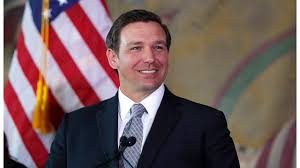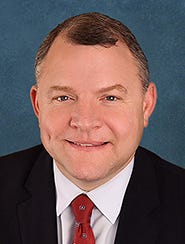Daytona Beach News-Journal Editorial Board
Sometimes it’s fun to try to figure out exactly what Gov. Ron DeSantis is thinking. And sometimes it just gives you a headache.
Take his appointments to the St. Johns River Water Management District Tuesday. For most governors, this would be a boring chore, barely worth a mention. But under DeSantis, it’s a saga – one that started like a superhero movie but has taken a definite twist toward the surreal.
DeSantis strode into office proclaiming himself to be a warrior in defense of Florida’s water – its rivers, lakes, lagoons and springs along with the vast underground aquifers that supply nearly all of the state’s drinking water.

It was a righteous cause. Iconic Florida waterways such as the Indian River Lagoon are choked with noxious algae blooms, and once-pure springs are bubbling up water fouled by petrochemicals and fecal bacteria.
DeSantis clearly intended to set himself apart from his predecessor Rick Scott, who stifled state environmental oversight and larded critical boards – such as the governing boards of Florida’s five water management districts – with development and business interests who said “yes” to nearly every request that came their way, with little regard to the long-term environmental damage they risked.
DeSantis wanted to be different. Within a few weeks of taking office, the new governor asked every member of the governing board of the South Florida Water Management District to resign – which they did.
He also pulled the plug on dozens of Scott’s late-term appointments, including three to the St. Johns River district board. Among them: The controversial chair of the board, consultant John Miklos, who had been targeted with ethics investigations stemming from his firm’s representation of clients seeking permits from the water management district.
Also getting the ax: Allan Roberts of St. Augustine and Janet Price of Fernandina Beach. They had already been serving on the governing board – in Price’s case, for nearly two years – though they had not yet been confirmed by the state Senate.

It was a bold move. And after all this housecleaning, one might have expected DeSantis to appoint fire-breathing defenders of Florida’s hydrological well-being to fill the vacancies. Instead he did … nothing.
Two more vacancies came open on the St. Johns board. They weren’t filled. The nine-member board was down to four members (one less than an official quorum). At the end of August, another seat opened.
Tuesday, DeSantis finally made a move. He appointed two – not six, just two – St. Johns board members. One of them, Sen. Rob Bradley, is an Orange Park Republican with a decent record of advocating for water-restoration projects during his legislative career, which is ending due to term limits.
The other? Janet Price – the same Fernandina Beach businesswoman DeSantis rejected so dramatically during his first months in office. Let’s be clear: Price’s previous tenure on the water management board was without controversy. But if she’s such a good fit with DeSantis’ vision for the St. Johns board, why didn’t he keep her on in the first place? If he was reconsidering Scott appointments, why didn’t he also tap Allan Roberts, who was the only governing-board member to stand up to Miklos?

And consider this: In the press release touting Price’s qualifications for the board, DeSantis’ press release left out one relevant fact: That she’d already served 22 months on the same board to which she was being appointed.
Head aching yet?
The last big question, of course, is what next? The governor has four more vacancies to fill. It would be great to see him name at least one person whose background lies in environmental advocacy – someone like former board members Ann Moore of Flagler County or Saundra Gray of DeBary.
He could also consider former board member Maryam Ghyabi, an Ormond Beach engineer, or former Volusia County Councilwoman Pat Northey, with a strong background in land preservation. We’ll throw one more name in the pot: St. Johns County Commissioner Henry Dean, who is uniquely qualified to serve on the board, having served as the water management district’s executive director for 17 years.
If the governor is serious about defending Florida’s water, he’ll find people who are willing to move aggressively to preserve and protect the state’s fragile hydrology. And he’ll put them to work – sooner, rather than later.
“The Invading Sea” is the opinion arm of the Florida Climate Reporting Network, a collaborative of news organizations across the state focusing on the threats posed by the warming climate.



